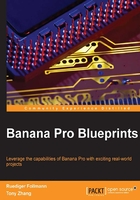
Chapter 2. Programming Languages
This chapter deals with programming languages. A single chapter, of course, cannot replace complete books that are dedicated to certain programming languages. However, when compiling or executing programs from the Internet, basic knowledge of programming languages may help to debug functionality and finally get things working as expected.
In this chapter, some basic principles, such as remote connections and editors, are explained. Afterwards, you will learn something about shell programming. This programming will be required later, for example, within Chapter 5, A Multimedia Center.
Python is a scripting language, which is interpreted on the fly. You will learn the basics of Python and a data visualization example is also provided.
Most program sources from the Internet are C/C++ programs. You will learn the basics of C using the GNU C-compiler, makefiles, and a debugger.
Another section deals with Scratch. Scratch is a graphical programming language for children aged 8 and upward. Each programming section contains an example of how to deal with external interfaces using GPIO or other buses.
The last section of this chapter deals with compiling and installing new kernels from a source. This is often needed in order to add certain functionality to a system. The following sections are covered in detail:
- Basic principles
- Bash
- Python
- C/C++
- Scratch
- New kernels